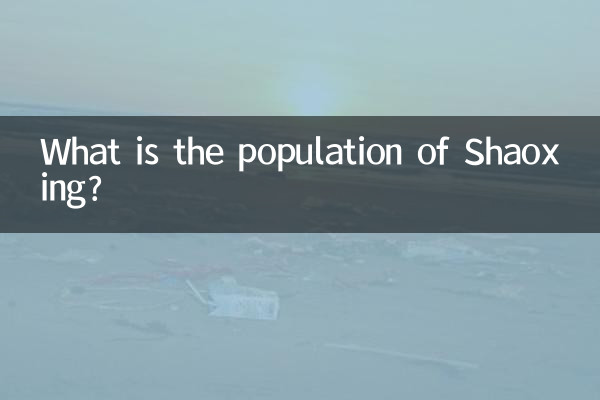What is the population of Shaoxing?
Shaoxing, as one of the important cities in Zhejiang Province, is famous for its long history and culture and prosperous economy. In recent years, with the development of cities and population mobility, Shaoxing's population data has also attracted much attention. This article will combine the hot topics and hot content on the Internet in the past 10 days to provide you with a detailed analysis of Shaoxing's population status and display relevant information through structured data.
1. Overall population situation of Shaoxing

According to the latest statistical data, the permanent population of Shaoxing City shows a steady growth trend. The following is the permanent population data of Shaoxing City in recent years:
| Year | Permanent population (10,000 people) | growth rate |
|---|---|---|
| 2020 | 527.1 | 1.2% |
| 2021 | 533.6 | 1.3% |
| 2022 | 540.2 | 1.2% |
As can be seen from the table, the permanent population of Shaoxing City will increase from 5.271 million in 2020 to 5.402 million in 2022, with an average annual growth rate of approximately 1.2%. This data reflects the population attractiveness of Shaoxing as an important city in the Yangtze River Delta region.
2. Population distribution in various districts and counties in Shaoxing
Shaoxing City has 6 districts and counties under its jurisdiction, with uneven population distribution. The following is the latest population data of each district and county:
| Districts and counties | Permanent population (10,000 people) | Proportion of the city |
|---|---|---|
| Yuecheng District | 102.3 | 18.9% |
| Keqiao District | 98.7 | 18.3% |
| Shangyu District | 78.5 | 14.5% |
| Zhuji City | 121.4 | 22.5% |
| Shengzhou City | 67.2 | 12.4% |
| Xinchang County | 72.1 | 13.4% |
Data show that Zhuji City has the largest population, reaching 1.214 million, accounting for 22.5% of the city's total population; Yuecheng District and Keqiao District follow closely, accounting for 18.9% and 18.3% respectively. This distribution pattern is closely related to the economic development level of each district and county.
3. Shaoxing’s population structure characteristics
The population structure of Shaoxing City shows the following characteristics:
| indicator | data |
|---|---|
| urban population ratio | 68.7% |
| Rural population ratio | 31.3% |
| Proportion of population aged 0-14 years old | 12.8% |
| Proportion of population aged 15-59 | 65.4% |
| Proportion of population aged 60 and above | 21.8% |
As can be seen from the table, Shaoxing’s urbanization rate is relatively high, reaching 68.7%; the working-age population (15-59 years old) accounts for 65.4%, showing a good demographic dividend; at the same time, the degree of aging (21.8%) is slightly higher than the national average, which will pose challenges to future urban development.
4. Population mobility in Shaoxing
In recent years, Shaoxing’s population mobility has shown the following trends:
| Year | Inflow population (10,000 people) | Outmigration population (10,000 people) | net inflow |
|---|---|---|---|
| 2020 | 25.3 | 18.7 | +6.6 |
| 2021 | 27.1 | 19.2 | +7.9 |
| 2022 | 28.5 | 20.1 | +8.4 |
Data show that Shaoxing City has maintained a net inflow of population for three consecutive years, and the net inflow has increased year by year, reaching 84,000 in 2022. This is mainly due to Shaoxing's superior geographical location and rapidly developing industrial economy.
5. The relationship between Shaoxing’s population and economic development
Population growth is closely related to economic development. The following are the main economic indicators of Shaoxing:
| indicator | 2020 | 2021 | 2022 |
|---|---|---|---|
| GDP (100 million yuan) | 5780 | 6250 | 6805 |
| GDP per capita (yuan) | 109,600 | 117,200 | 125,900 |
| Disposable income of urban residents (yuan) | 62,300 | 67,500 | 72,800 |
Continued economic growth provides strong support for population agglomeration. Shaoxing's per capita GDP will reach 125,900 yuan in 2022, which is much higher than the national average. This is an important factor in attracting population inflow.
6. Future population development trends
According to the plan, Shaoxing’s permanent population is expected to reach 5.5-5.6 million people by 2025. To achieve this goal, Shaoxing is taking the following measures:
1. Optimize industrial structure and attract high-end talents
2. Improve public services and improve urban livability
3. Strengthen regional collaboration and promote reasonable population mobility
4. Promote new urbanization and improve the quality of urbanization
To sum up, Shaoxing currently has a permanent population of approximately 5.402 million, showing a steady growth trend. As an important node city in the Yangtze River Delta urban agglomeration, Shaoxing's population development will inject continued impetus into the regional economy.

check the details

check the details